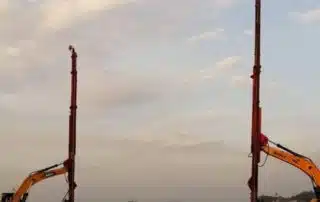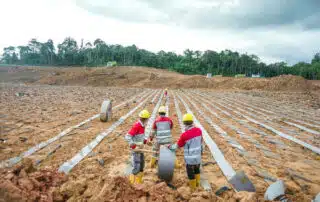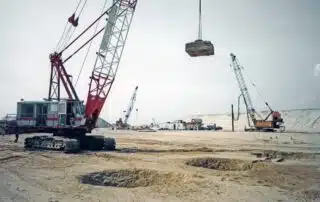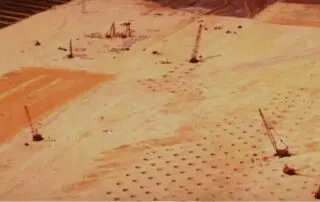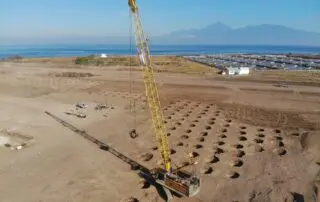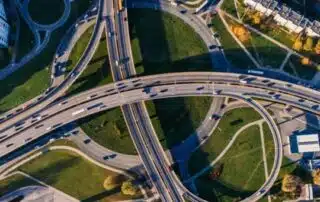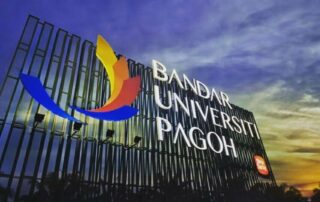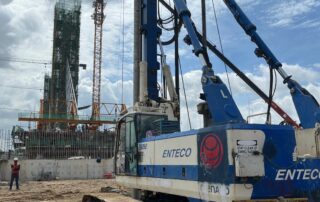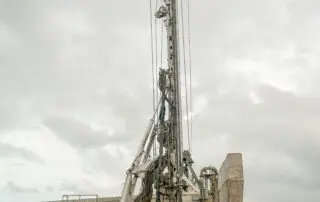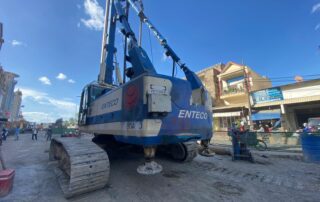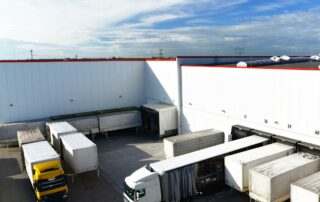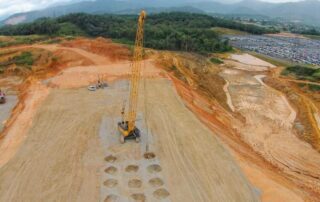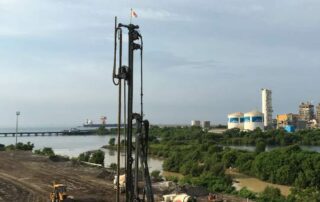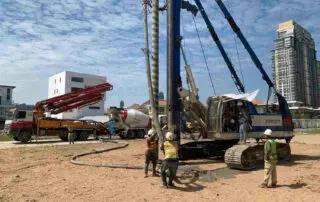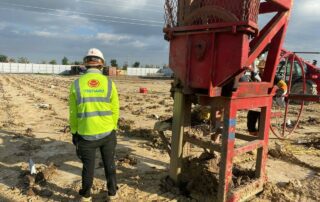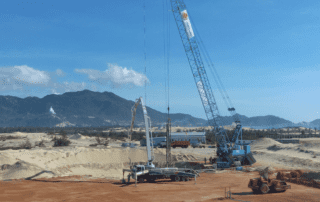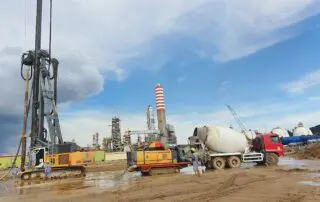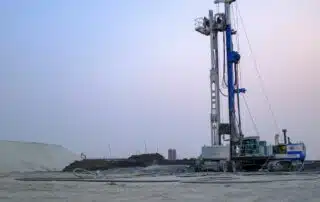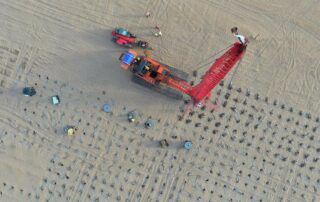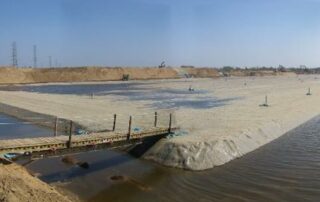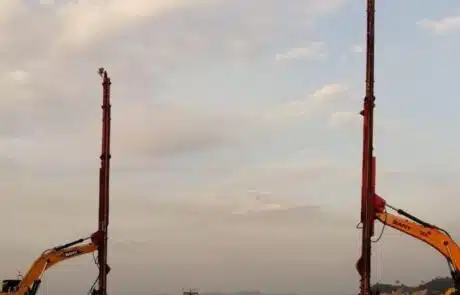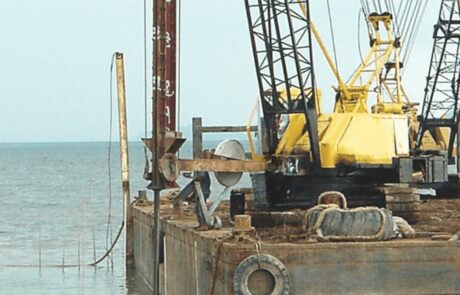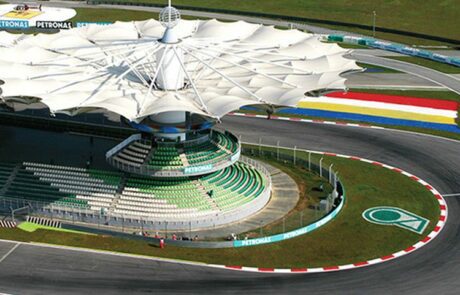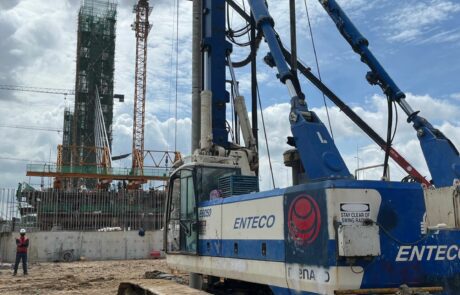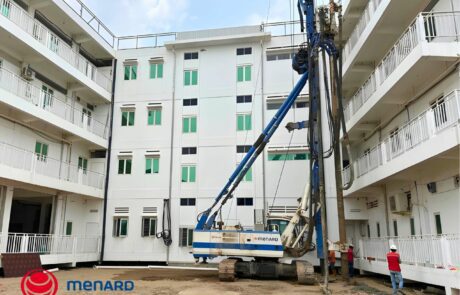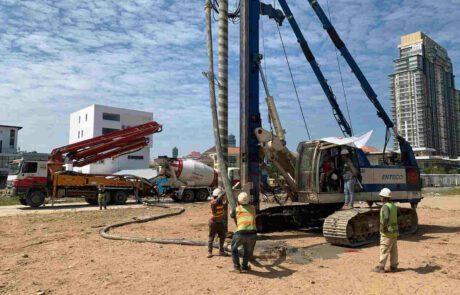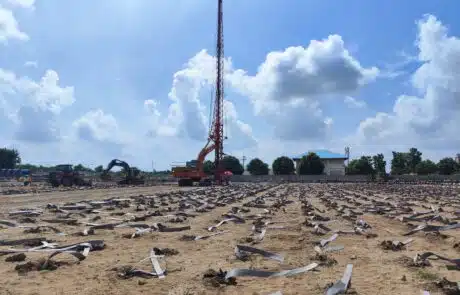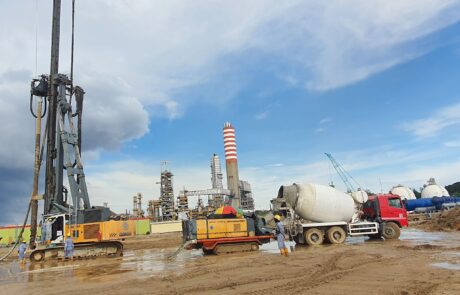Menard Asia delivers the full range of ground improvement techniques to provide effective and innovative solutions for its clients. Our teams design, build and refurbish all types of road, airport, railway, marine, inland waterway, hydraulic, commercial, industrial and energy infrastructure.
Ports and Airports
The land available on riverbanks and coasts on which port and airport infrastructure are built can often consist of compressible terrain which is saturated with water. Given the large surface areas which is generally (several hectares) required, land for ports and airports platforms are often reclaimed from the sea by means of hydraulic or terrestrial backfill. Cost-effective ground treatment techniques are very commonly used to treat such sites. Ground improvement works make it possible to accelerate sub-soil consolidation and thus ensure low residual settlement during operation of the infrastructure. When the foundations of the infrastructure require, intensive treatment of filled materials can increase their load-bearing capacity and reduce thrust on quay walls. In cases of strong seismic loading, the treatment can include measures to reduce the risk of liquefaction. This type of project calls for the use of substantial resources to treat large surface areas within a relatively short period of time.
Roads and Railways
Transport infrastructure – roads and railway systems – are frequently built in areas where the soil is highly compressible, such as swamps, marshes or areas near watercourses. In such cases, substantial consolidation work is required to avoid shear failure of the fill used to build the structure. This type of project requires simultaneous management of multiple sites along the alignment and can often involve the use of a variety of solutions to meet the wide-ranging geotechnical conditions and specific constraints of the terrain. To ensure the long-term integrity of the infrastructure and the safety of the vehicles using it, it is essential that these areas are “over-consolidated” to reduce settlement due to primary settlements, creep and to limit differential settlement. For engineering structures built along the alignment, backfill generates very high loads associated with strict settlement limitations. These critical areas generally require even more extensive treatment and careful management of the interfaces.
Building
Ground improvement techniques are particularly well suited to load bearing structures (slabs, and columns supported on pads) in buildings, and more particularly industrial, wholesale and retail and logistics facilities (warehouses, storage, processing, datacentres and distribution centres). These types of project require rigorous organisation to manage scheduling and interfaces among a large number of project participants on the worksite. Rapid execution and on-time delivery are crucial to the success of these projects. Menard has developed ground reinforcement systems that cause little disruption (waste, noise, vibrations, etc.), can be rapidly implemented and are well suited to these types of projects. These solutions are also used to create safe and cost-effective surface foundations for these structures without direct mechanical connection between the foundations and the structure. This simplifies and accelerates construction and reduces the cost of the structure compared to conventional solutions using deep foundations.
Process and Energy
Industrial plant and equipment consist of special structures that are often very heavy and sensitive. When foundations are built on compressible soils, careful consideration must be taken during design and execution to ensure the safe operation of the plant within the structure. The most cost-effective foundation solutions generally call for a combination of ground improvement techniques suited to the load and the soil conditions. These solutions make it possible to: – support heavy uniform loads (water, oil and gas storage) – support individual loads (pipeline supports, industrial equipment) – support dynamic loads (oscillations, vibrations, seismic loadings) – reduce absolute and differential settlement of structures. – reduce the risk of soil liquefaction This type of project calls for good knowledge of the constraints and specifications of each structure to be treated with a familiarity with the potential technical issues which could arise during the various stages of the project from concept to handover.
Menard Asia delivers the full range of ground improvement techniques to provide effective and innovative solutions for its clients. Our teams design, build and refurbish all types of road, airport, railway, marine, inland waterway, hydraulic, commercial, industrial and energy infrastructure.
Ports and Airports
The land available on riverbanks and coasts on which port and airport infrastructure are built can often consist of compressible terrain which is saturated with water. Given the large surface areas which is generally (several hectares) required, land for ports and airports platforms are often reclaimed from the sea by means of hydraulic or terrestrial backfill. Cost-effective ground treatment techniques are very commonly used to treat such sites. Ground improvement works make it possible to accelerate sub-soil consolidation and thus ensure low residual settlement during operation of the infrastructure. When the foundations of the infrastructure require, intensive treatment of filled materials can increase their load-bearing capacity and reduce thrust on quay walls. In cases of strong seismic loading, the treatment can include measures to reduce the risk of liquefaction. This type of project calls for the use of substantial resources to treat large surface areas within a relatively short period of time.
Roads and Railways
Transport infrastructure – roads and railway systems – are frequently built in areas where the soil is highly compressible, such as swamps, marshes or areas near watercourses. In such cases, substantial consolidation work is required to avoid shear failure of the fill used to build the structure. This type of project requires simultaneous management of multiple sites along the alignment and can often involve the use of a variety of solutions to meet the wide-ranging geotechnical conditions and specific constraints of the terrain. To ensure the long-term integrity of the infrastructure and the safety of the vehicles using it, it is essential that these areas are “over-consolidated” to reduce settlement due to primary settlements, creep and to limit differential settlement. For engineering structures built along the alignment, backfill generates very high loads associated with strict settlement limitations. These critical areas generally require even more extensive treatment and careful management of the interfaces.
Building
Ground improvement techniques are particularly well suited to load bearing structures (slabs, and columns supported on pads) in buildings, and more particularly industrial, wholesale and retail and logistics facilities. These types of project require rigorous organisation to manage scheduling and interfaces among a large number of project participants on the worksite. Rapid execution and on-time delivery are crucial to the success of these projects. Menard has developed ground reinforcement systems that cause little disruption (waste, noise, vibrations, etc.), can be rapidly implemented and are well suited to these types of projects. These solutions are also used to create safe and cost-effective surface foundations for these structures without direct mechanical connection between the foundations and the structure. This simplifies and accelerates construction and reduces the cost of the structure compared to conventional solutions using deep foundations.
Process and Energy
Industrial plant and equipment consist of special structures that are often very heavy and sensitive. When foundations are built on compressible soils, careful consideration must be taken during design and execution to ensure the safe operation of the plant within the structure. The most cost-effective foundation solutions generally call for a combination of ground improvement techniques suited to the load and the soil conditions. These solutions make it possible to: – support heavy uniform loads (water, oil and gas storage) – support individual loads (pipeline supports, industrial equipment) – support dynamic loads (oscillations, vibrations, seismic loadings) – reduce absolute and differential settlement of structures. – reduce the risk of soil liquefaction This type of project calls for good knowledge of the constraints and specifications of each structure to be treated with a familiarity with the potential technical issues which could arise during the various stages of the project from concept to handover.

